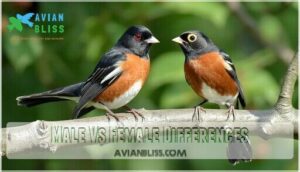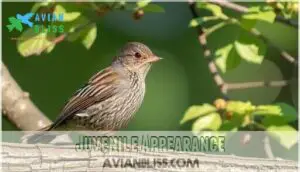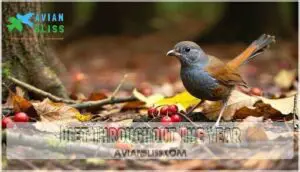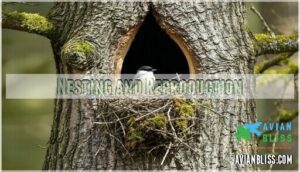This site is supported by our readers. We may earn a commission, at no cost to you, if you purchase through links.

These chunky songbirds inhabit dense undergrowth from southeastern Canada to Florida, using their signature two-footed backward scratch to forage through leaf litter like they’re performing a little dance.
They’re famous for their clear "drink-your-tea" song and sharp "chewink" call that echoes through shrubby thickets.
During breeding season, they shift from eating insects to seeds, with males fiercely defending territories while females build cup-shaped nests low in dense vegetation.
Their distinctive foraging technique and territorial displays reveal fascinating behavioral adaptations.
Table Of Contents
- Key Takeaways
- Eastern Towhee Identification
- Habitat and Range
- Behavior and Diet
- Nesting and Reproduction
- Songs, Calls, and Communication
- Frequently Asked Questions (FAQs)
- Where does the eastern towhee live?
- What is the density of eastern towhees?
- How much do eastern towhees move a day?
- Is the Eastern Towhee rare?
- What is special about Eastern Towhee?
- What does it mean when you see an Eastern Towhee?
- What does a female Eastern Towhee look like?
- How long do Eastern Towhees?
- What are the main threats to Eastern Towhees?
- Do Eastern Towhees migrate?
- Conclusion
Key Takeaways
- You’ll identify eastern towhees by their bold black heads and rufous sides on males, while females show warm brown tones with the same striking pattern
- You can spot their unique two-footed backward scratching technique as they forage through leaf litter like they’re performing a dance
- You’ll hear them before you see them with their clear "drink-your-tea" song and sharp "chewink" call echoing through dense undergrowth
- You’ll find them in shrubby thickets and woodland edges from southeastern Canada to Florida, where they build cup-shaped nests low in dense vegetation
Eastern Towhee Identification
You’ll recognize this striking bird by its bold black and rufous plumage that makes it stand out among the undergrowth where it forages.
This flashy bird’s black and orange colors make it impossible to miss in the brush
Males display jet-black heads and backs with bright orange-red sides, while females show the same pattern in warm brown tones instead of black.
Physical Characteristics
When you spot this chunky body sparrow, you’ll notice its seedcracking bill and long rounded tail immediately.
Eastern towhees showcase striking feather patterns with bold plumage variation between sexes.
Their eye colors range from red to white, while their robust body size makes identification easier, complementing their distinctive plumage markings and the beak shape perfectly suits their ground-foraging lifestyle.
Male Vs Female Differences
Looking at eastern towhee sexual dimorphism, you’ll notice striking plumage distinctions between sexes.
Males sport jet-black heads and backs with brilliant rufous sides, while females display warm brown tones replacing the male’s black areas.
Both sexes share white bellies, but males show sharper color contrasts.
Eye color varies regionally, typically red except in southern populations with pale yellow eyes.
Juvenile Appearance
Young eastern towhee birds wear streaky brown plumage that resembles their sparrow family cousins.
Their beak color appears duller than adults, while eye coloration hasn’t developed the characteristic red hue. Feather development progresses gradually, with plumage patterns transforming after their first molt into bold adult colors.
These juvenile birds show distinct streaking features across their chest and back, making bird identification challenging for beginners. Understanding bird identification techniques is essential for accurately distinguishing between similar species, using effective techniques.
Comparison to Sparrows
Eastern towhees are roughly 30% larger than Song Sparrows and twice as heavy, making size comparison straightforward.
These ground dwelling birds sport chunky builds with thick, triangular beaks perfect for cracking seeds, while sparrows have thinner bills.
Eastern towhee plumage difference is striking—bold black-and-rufous patterns versus sparrows’ streaky brown feathers.
Their leg color and distinctive song patterns also separate these bird species from typical sparrow varieties.
Habitat and Range
You’ll find Eastern Towhees in dense undergrowth, shrubby thickets, and woodland edges from southeastern Canada down to Florida.
These birds prefer overgrown fields and brushy backyards, with northern populations migrating south while southern birds stay put year-round, in their preferred woodland edges.
Preferred Environments
You’ll find these birds thriving in specific habitat types that offer the perfect blend of cover and foraging opportunities.
Eastern towhees gravitate toward areas where dense undergrowth meets open spaces, creating ideal conditions for their ground-scratching lifestyle.
- Forest edges where woodlands meet clearings or fields
- Shrub lands with thick vegetation 2-5 feet tall
- Woodland clearings created by natural or human disturbance
- Brush habitats in old fields and abandoned farmland
- Dense undergrowth with abundant leaf litter for foraging
They often inhabit areas with specific breeding habitat needs that support their population abundance.
Geographic Distribution
Spanning eastern townee territories across North America reveals fascinating Regional Variations in their Geographic Distribution.
You’ll find their Breeding Range stretching from southern Canada through the eastern United States to Florida, with distinct Habitat Zones supporting year-round populations in southeastern states.
Winter Migration patterns show northern birds heading south, creating overlapping territories where resident and migrant populations coexist throughout colder months, influenced by their Geographic Distribution.
Migration Patterns
Northern populations don’t stick around when winter arrives – they’ll migrate several hundred miles southward to escape harsh weather.
You’ll find these eastern towhee migration patterns fascinating: birds follow established flyway patterns during fall migrations from September through November.
Their wintering grounds stretch across southeastern states, where milder climates and abundant food sources support survival.
Spring breeding seasons trigger return journeys northward by May.
Overlap With Other Species
While migration takes Eastern Towhees across vast territories, their journeys create fascinating species interactions with other birds.
Habitat sharing occurs frequently, though competitive behavior and territorial disputes shape these relationships. Niche partitioning helps reduce direct competition among ground forager species.
Key overlapping species include:
- Spotted towhee – hybridizes in Great Plains contact zones
- Brown-headed cowbird – notorious brood parasite targeting towhee nests
- Song sparrows – compete for similar undergrowth territories
- Cardinals – share dense shrubland preferences
- Catbirds – overlap in thicket sympatric occurrence
Behavior and Diet
You’ll discover eastern towhees are ground-dwelling specialists that spend most of their time scratching through leaf litter with a distinctive two-footed backward kick.
Their behavior changes dramatically with the seasons, shifting from insect-heavy diets during breeding season to seed-focused foraging in winter months.
Foraging Habits
You’ll discover eastern towhee ground foraging through their signature double-scratch technique.
These bird foraging behavior experts hop forward, then kick back with both feet simultaneously, clearing leaf litter to expose hidden arthropods and seeds.
This ground forager spends most daylight hours scratching beneath dense shrubs, making them excellent insect hunting specialists while maintaining their seed eating habits.
The eastern towhee’s foraging habits exhibit complex ground feeding behaviors that support ecosystem functions like seed dispersal and pest management.
Diet Throughout The Year
Eastern towhees adapt their foraging strategy like skilled chefs switching between seasonal menus.
Like master foragers, Eastern Towhees switch their menu with the seasons
Their ground scratching technique uncovers different treasures throughout the year:
- Spring surge – Over 60% insect foraging for protein-packed arthropods
- Summer bounty – Fruit eating peaks with 20% berry consumption
- Fall stockpiling – Seed consumption jumps to 70% for winter prep
- Winter survival – Ground scratching reveals persistent seeds and mast
The birds’ diet consists of various food sources, including seeds from a bird seed mix.
Social Structure
You’ll find Eastern Towhees are surprisingly independent birds that prefer solo living most of the year.
During breeding season, they form strong monogamous pair bonds, working together to raise their young.
Outside of mating season, these territorial birds rarely engage in flocking behavior unless harsh weather forces them into temporary groups for survival.
Territoriality and Displays
Male eastern towhees are fierce guardians of their 1-2 acre territories.
You’ll witness dramatic threat displays including tail fanning and wing spreading that expose brilliant white patches.
These territorial marking behaviors, combined with aggressive border patrols and loud towhee calls, establish clear dominance hierarchy.
During courtship rituals, males use elevated perches for maximum impact, chasing intruders relentlessly.
The eastern towhee’s defense of its territory is also influenced by its ground foraging habits, which plays a crucial role in its territorial marking behaviors and overall defense strategy.
Nesting and Reproduction
You’ll find Eastern Towhees nesting in dense shrubs and low branches, typically within three feet of the ground where thick vegetation provides cover.
The female builds a cup-shaped nest using twigs, bark strips, and leaves, then incubates 3-4 speckled eggs while the male guards their territory nearby, which is a crucial aspect of their territory.
Nest Placement
You’ll find towhee bird nests tucked away in dense shrubs or ground nesting sites beneath thick vegetation.
Eastern towhee nesting involves careful site selection, with females choosing spots 1-12 feet high in vegetation density that provides excellent nest concealment.
These towhee breeding habits prioritize security over convenience—they’ll pick the most tangled, impenetrable thicket available for maximum protection from predators and weather.
The choice of nesting site often depends on the availability of suitable shrub for nesting materials, which is crucial for nest concealment and overall breeding success.
Nest Description
You’ll find the female’s nest architecture features a shallow cup shape crafted from leaves, bark strips, and twigs.
These nesting materials create a sturdy foundation typically measuring 4-5 inches across.
The eastern towhee nest sits snugly in dense shrubs, with branch placement usually 1-10 feet high.
Bird nesting experts note these structures blend seamlessly into surroundings, making eastern towhee nesting sites remarkably well-camouflaged with natural materials.
Eggs and Chick Rearing
Watching eastern towhee egg laying reveals nature’s delicate timing – females typically produce 2-6 speckled eggs over consecutive days.
During the 12-13 day incubation period, chick growth accelerates rapidly once hatching begins.
These altricial nestlings gain nearly a gram daily through constant insect feeding, achieving fledgling care readiness within 10-12 days for ideal nesting success.
Understanding nest construction techniques is vital for appreciating the complex reproductive behaviors of birds like the eastern towhee.
Parental Roles
Both parents share eastern towhee responsibilities throughout brood rearing, though each has distinct roles.
While females handle most nest building and incubation duties, males actively participate in chick care and parental defense.
This monogamous pair works together during bird breeding season, with their teamwork ensuring successful bird nesting outcomes.
- Nest Building: Females construct the nest while males guard territory and assist with material gathering
- Chick Care: Both parents feed nestlings insects and arthropods every few minutes during daylight hours
- Parental Defense: Males lead aggressive mobbing behavior against predators while females protect the nest directly
- Mate Selection: Pairs form monogamous bonds that last throughout the breeding season with shared responsibilities
- Brood Rearing: Parents coordinate feeding schedules and continue caring for fledglings after they leave the nest
Songs, Calls, and Communication
You’ll recognize Eastern Towhees long before you see them thanks to their loud, distinctive vocalizations echoing through dense undergrowth.
Their scratchy "chewink" call and clear "drink-your-tea" song make them one of the easiest birds to identify by sound alone, with the "chewink" being particularly distinctive.
Signature Calls and Songs
Through dense underbrush, you’ll hear the eastern towhee’s signature "drink-your-tea!" song echoing from hidden perches.
This metallic call lasts about one second, featuring a sharp introductory note followed by a rapid trill.
Males sing exclusively, often alternating between multiple song patterns during territorial displays.
The distinctive "chewink" call gives this bird its name and serves as both alarm and contact communication in thick vegetation.
Understanding bird song patterns is essential to recognizing the eastern towhee’s unique vocalizations and territorial displays.
Vocalization Functions
Understanding these vocal patterns reveals the secret language of Eastern Towhees.
Their bird calls serve distinct purposes – territorial calls defend breeding areas while courtship songs attract mates.
The famous "chewink call" establishes dominance, and their "drink-your-tea" song structure signals reproductive fitness.
Bird songs demonstrate vocal learning abilities that strengthen pair bonds and coordinate daily social routines effectively, showcasing their ability to learn and adapt, a key factor in their reproductive fitness.
Seasonal Singing Behavior
You’ll hear eastern towhee song peak from April through July when breeding songs and mating melodies dominate their repertoire.
Males belt out 40-80 territorial chants per hour at dawn, emphasizing that classic "drink-your-tea" phrase.
By August, seasonal trills fade to near-silence as winter calls replace complex vocalizations.
Northern populations extend their chewink call performances longer than southern birds during eastern towhee migration periods.
Visual Displays and Mobbing
Beyond their vocal repertoire, you’ll notice eastern towhees use dramatic threat displays when defending territory.
Males fan their tails, spread wings, and raise head feathers to appear larger.
During nesting season, both sexes engage in mobbing behavior against predators, calling loudly while diving at threats.
These visual cues and alarm calls coordinate group defense, turning solitary birds into fierce protectors of their woodland domain.
Frequently Asked Questions (FAQs)
Where does the eastern towhee live?
You’ll find these feathered comedians refusing fancy neighborhoods, preferring life’s messier corners instead.
Eastern towhees inhabit dense shrubs, thickets, and woodland edges from southern Canada to Florida throughout eastern North America.
What is the density of eastern towhees?
Population density varies dramatically, but you’ll typically find 10 pairs per 40 hectares at forest edges.
Dropping to 1 pair per 40 hectares deeper inside is a significant decrease, illustrating the impact of location on population density.
Prime habitats can support 30-80 pairs per 40 hectares in ideal conditions.
How much do eastern towhees move a day?
You’ll track about 325 feet per day as you forage and defend territory.
Studies in South Carolina forests found daily movement averaged 325 feet, with birds roaming beyond their capture sites throughout seasonal cycles.
Is the Eastern Towhee rare?
The Eastern Towhee isn’t rare—you’ll spot these chunky sparrows throughout eastern North America. They’re common year-round residents in southeastern states, though northern populations migrate south for winter.
What is special about Eastern Towhee?
You’ll love how towhees use their signature two-footed scratching technique, hopping backward through leaf litter like tiny dancers. Their bold rufous sides and distinctive "drink-your-tea" song make identification easy.
What does it mean when you see an Eastern Towhee?
Birds of a feather flock together, and spotting an Eastern Towhee means you’re in prime brushy habitat where these ground-scratching sparrows thrive, indicating healthy undergrowth ecosystems perfect for wildlife.
What does a female Eastern Towhee look like?
Female towhees sport warm brown heads and backs instead of black, while keeping those signature rufous sides and white bellies.
You’ll spot the same chunky sparrow build, but with softer, earthier tones throughout.
How long do Eastern Towhees?
Time flies when you’re watching these chunky sparrows.
You’ll typically see Eastern Towhees living 2-8 years in the wild, though some lucky birds reach 12 years with good habitat and minimal predation.
What are the main threats to Eastern Towhees?
You’ll face persistent threats from cats, raccoons, and habitat loss.
The Eastern Towhee’s ground-nesting habit makes it particularly vulnerable to predation by outdoor cats, while loss of suitable habitat due to landscape conversion remains their biggest challenge.
Do Eastern Towhees migrate?
Migration patterns absolutely vary by region – northern Eastern Towhee populations undertake seasonal journeys south, while their southern cousins remain year-round residents in warmer territories, creating a fascinating geographic divide.
Conclusion
Surprisingly, you’ll find the eastern towhee thriving in your backyard shrubs just as readily as in remote forest edges.
These adaptable birds demonstrate remarkable behavioral flexibility, switching between territorial displays and cooperative foraging as seasons change.
You’ve now learned to identify their distinctive markings, recognize their memorable calls, and understand their unique scratching technique.
Whether you’re watching males defend nesting territories or observing their methodical leaf-litter searches, the eastern towhee offers endless opportunities for backyard birdwatching discoveries, with its unique scratching technique being a key aspect of its behavior.














